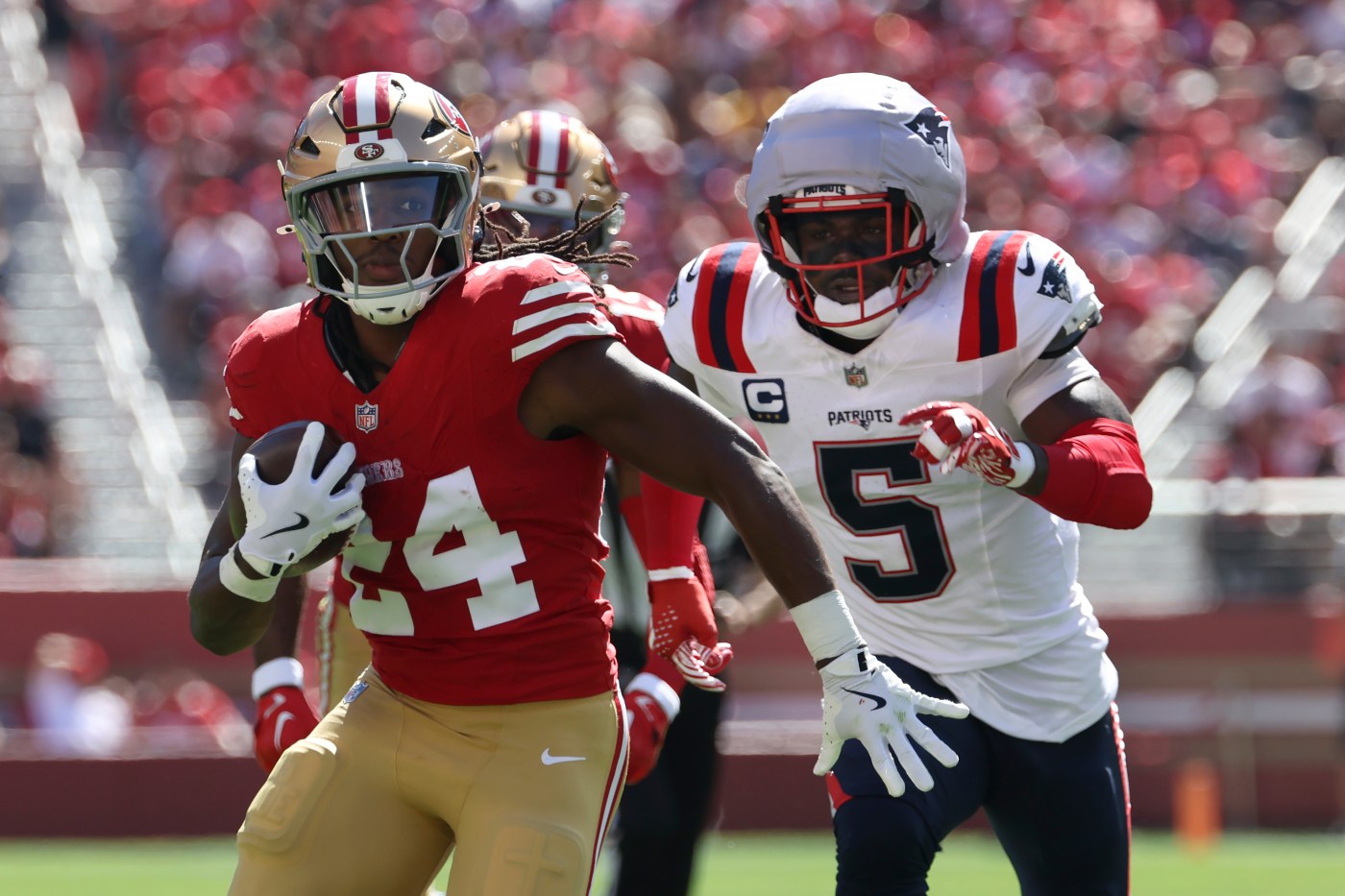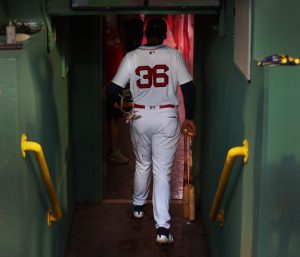
Patriots-49ers film review: How Jerod Mayo’s offense and defense got exposed in San Francisco
If you ever visit the Pro Football Hall of Fame, you might notice an open blue binder encased in glass displaying scribbled diagrams and code words for in-game adjustments.
This is the only game plan in the Hall of Fame. Naturally, it’s a Bill Belichick brainchild.
The binder is a memento to both Belichick’s genius and Super Bowl XXV, one of the most unforgettable in history. That year, Belichick’s Giants upset the favorite Bills thanks partly to a unique game plan that baited a record-setting Buffalo offense into running the ball at an atypically high rate. After dropping 51 points in the AFC Championship Game, the Bills scored just 19 in the Super Bowl and lost.
Belichick’s idea – prioritizing pass defense at the expense of stopping the run by playing lighter personnel – now defines modern defense. Teams across today’s NFL play more defensive backs and more two-high coverage than ever before.
Now, if Jerod Mayo must make do with the mess of a roster Belichick left him, he might as well steal from his old boss’s most famous plan. Because on Sunday, the Patriots’ insistence on stopping the run arguably cost them control of the game as much as their three turnovers and putrid pass protection.
Like their offense, the Pats defense now ranks bottom 10 by contextualized metrics like EPA and DVOA; in part because of injuries, and the fact they were out-coached for a third straight game.
In the first quarter Sunday, 49ers coach Kyle Shanahan probed the the Patriots for how they would react to certain personnel packages. He deployed groupings with multiple backs, two tight ends and even one with no running backs at all. In most cases, the Patriots preferred to play with big personnel that featured only four defensive backs, a clear commitment to stop San Francisco’s run game.
No problem.
Shanahan baited the Patriots into keeping their beefy base personnel on the field for more than 60% of their snaps, and lulled them into a false sense of security by calling runs that gained few yards and felt like landed body blows for the defense. And when the 49ers passed against this slow-footed group, they landed knockout punches.
San Francisco scored on four of its first five drives and averaged more than 16 yards per dropback versus the Patriots’ base defense. The Niners picked up their five longest gains of the game against this personnel, including four passes longer than 30 yards and excluding two touchdowns nullified by penalty. Defensive coordinator DeMarcus Covington did them a solid here, even playing base defense on second-and-10 and second-and-15.
Veteran defenders later bemoaned poor edge-setting against the run and poor quarterback contain, both of which were issues. But these explosive plays, and the inability to stop the pass from their most frequent personnel grouping, were the two main reasons they lost.
Of note: Pats safety Kyle Dugger left with an injured ankle in the first half, a crucial loss that affected the defense’s ability to play as big as possible through five defensive backs. But would Dugger’s return have put a serious dent into a 17-point margin of defeat? Doubtful.
Might better coaching have kept the Patriots close? Yes.
Offensively, the Pats remain a disaster; not merely because of the NFL’s worst pass protection, which allowed Jacoby Brissett to get hit or hurried on more than half his dropbacks Sunday. But Brissett may finally be showing signs of cracking, while Alex Van Pelt’s passing game is too static and Rhamondre Stevenson fumbled yet again.
Here’s what else the film revealed about the Patriots’ latest loss:
Jacoby Brissett
19-of-32 for 168 yards, TD, INT
New England Patriots quarterback Jacoby Brissett, left, scrambles from San Francisco 49ers defensive end Nick Bosa during the second half of an NFL football game in Santa Clara, Calif., Sunday, Sept. 29, 2024. (AP Photo/Jed Jacobsohn)
Accurate throw percentage: 72.4%
Under pressure: 5-of-13 for 92 yards, INT, 6 sacks, 1 rush yard
Against the blitz: 7-of-11 for 100 yards, TD, 2 sacks
Behind the line: 5-of-6 for 17 yards
0-9 yards downfield: 13-of-18 for 130 yards, TD
10-19 yards downfield: 0-of-2, INT
20+ yards downfield: 1-of-3, 21 yards
His worst game as a Patriot.
Brissett was a walking disaster under pressure, fumbling three times, causing two sacks and tossing a pick-six. His total passing yards were significantly inflated by Antonio Gibson’s 50-yard catch-and-run against a busted coverage in garbage time. Set that aside, and Brissett’s numbers reflect the type of scattershot game he had; one the Patriots cannot survive, unless they pair it with a defensive touchdown or a dominant rushing day.
Of course, coming under fire more than 50% of the time will affect a quarterback. For the first time this season, Brissett seemed to have trouble seeing the middle of the field, where a couple quicker triggers would have led to more completions. He was much more effective against the blitz, when he had no choice but to unload the ball within two seconds.
Only one of his completions traveled more than 10 yards through the air.
Jacoby Brissett’s passing chart in Week 4 at San Francisco. (Via Next Gen Stats).
Games like this will come and go, but it’s fair to wonder whether the unprecedented pressure Brissett is facing (49% of his dropbacks this season) is having a compound affect. Otherwise, his toughness deserves mention here, as he continues to get clobbered in a way that’s downright alarming (10 more QB hits) and engendering serious respect among his teammates. He also finally completed his first deep pass of the season, a 21-yard back-shoulder throw to Ja’Lynn Polk in the third quarter.
Critical areas
Turnovers: Patriots 3, 49ers 2
Explosive play rate: Patriots 4.8%, 49ers 11.7%
Success rate: Patriots 31.7%, 49ers 40%
Red-zone efficiency: Patriots 1-2, 49ers 2-4
Defensive pressure rate: Patriots 23%, 49ers 51.2%
Offense
New England Patriots quarterback Jacoby Brissett (7) looks to pass while pressured by San Francisco 49ers defensive end Nick Bosa, bottom, defensive end Leonard Floyd, middle left, and defensive end Yetur Gross-Matos (94) during the second half of an NFL football game in Santa Clara, Calif., Sunday, Sept. 29, 2024. (AP Photo/Godofredo A. Vásquez)
Game plan
Personnel breakdown: 58% of snaps in 11 personnel, 35% snaps in 12 personnel, 5% snaps in 21H personnel, 3% in 13 personnel.***
Personnel production: 26% success rate in 11 personnel, 43% success rate in 12 personnel, 0% in 21H personnel, 50% success rate in 13 personnel.
First-down down play-calls: 56.5% run (46% success rate), 43.5% pass (30% success rate)
Play-action rate: 10%
The good news: offensive coordinator Alex Van Pelt emphasized a quick passing plan that gave Brissett the chance to stay clean early in the game.
The bad: Brissett got buried anyway. Van Pelt’s pass concepts hardly threatened the 49ers, who repeatedly drove on isolation routes outside and were not stressed by pre-snap movement or route combinations that put them in conflict often enough. Brissett had multiple passes knocked away on short curl routes, and got knocked around himself on half his dropbacks.
Van Pelt opened by helping left tackle Demontrey Jacobs with double-teams against 49ers defensive Nick Bosa that often involved tight end Hunter Henry. Jacobs allowed just a single pressure in the first half. But as the game progressed, the double-teams stopped, Van Pelt relied on Brissett to avoid pressure on his own with a quick release. In the second half, Jacobs surrendered two hurries, one quarterback hit and Bosa’s sack.
Downfield, as the old wisdom goes, coaches get receivers open versus zone coverage, and receivers get themselves against versus man-to-man. The Patriots faced zone coverage on 79% of their passing plays and averaged 3.5 yards per dropback; a clear coaching failure.
Compounding matters was the fact the Pats played with three receivers on most of their snaps, and this was by far their least effective personnel group. Their 26% success rate from 11 personnel (three receivers, one running back, one tight end) was the lowest produced by any grouping this season that took at least 10 snaps in one game.
Bottom line: the wideouts can’t get open, the play-calling and play design haven’t helped, and defenses are still smothering Van Pelt’s attempted play-action shots from midfield. By the end, Van Pelt seemed to punt on the idea of a comeback, calling runs on more than 50% of the Patriots’ first-down plays in the second half.
Player stats
Broken tackles: RB Rhamondre Stevenson 7, RB Antonio Gibson 2, RB JaMycal Hasty 1, WR DeMario Douglas 1
Pressure allowed: LT Demontrey Jacobs 5 (sack, 2 QB hits, 2 hurries), RG Layden Robinson 5 (sack, 2 QB hits, 2 hurries), RT Mike Onwenu 3 (QB hit, 2 hurries), QB Jacoby Brissett 2 (2 sacks), LG Sidy Sow 2 (QB hit, hurry), C Nick Leverett (hurry), Team 2 (2 sacks)
Run stuffs allowed: Team 2, Sow 2, Robinson, TE Hunter Henry, WR Tyquan Thornton
Drops: WR Ja’Lynn Polk, Gibson, Stevenson
Notes
Rhamondre Stevenson cannot keep fumbling. Until the Pats find a way to activate DeMario Douglas – if they ever do – Stevenson is their only reliable playmaker, particularly in space; a fact that is likely keeping him on the field.
Stevenson is fumbling on more than one of every 20 touches this season, an untenable number that risks a turnover per game for an offense that can’t afford it.
Speaking of turnovers, Brissett clung to the ball for 3.05 seconds on his pick-six. He seemed to miss 49ers linebacker Fred Warner in the middle of the field, as San Francisco bailed from a blitz look into Cover 2. Brissett stared down a good route against Cover 2, but made a bad throw with worse timing.
Second-round rookie Ja’Lynn Polk has established himself as the Pats’ best all-around receiver, even if he has yet to put it all together in a single game and had a tough fourth-quarter drop. Brissett targeted him at all three levels of the field. Polk deserves full-time reps.
It’s hard to build an argument for Tyquan Thornton seeing regular offensive snaps anymore. Stevenson has more fumbles this season than Thornton has catches.
The injury absence of center David Andrews (shoulder) hurt less than expected. Backup guard/center Nick Leverett didn’t botch a single snap and allowed a single pressure, best among the offensive linemen.
Left guard Sidy Sow made his season debut and showed some rust in the run game, specifically with the timing of his double-teams. He allowed a team-worst two run stuffs.
Rough, rough outing for rookie right guard Layden Robinson. He lost badly in 1-on-1 pass protection and continues to get beat on two-man stunts.
Tight ends Hunter Henry and Austin Hooper should expect more snaps going forward. They’ve been steady and unspectacular, and can offer more help in protection than what the Pats have been able to muster in spread sets.
Nice play-call on the fourth-and-1 play-action pass that sprung Hooper for a touchdown. Everyone in the stadium expected run, and Van Pelt delivered in a key spot.
Defense
Game plan
Personnel breakdown: 60% base, 18% three-corner nickel package, 12% dime, 9% three-safety nickel****
Coverage breakdown: 70% zone, 30% man
Blitz rate: 20%
Blitz efficacy: 50% offensive success rate, 25 yards per play allowed and 1 touchdown
Defensive coordinator DeMarcus Covington stuck with his 3-4 personnel through thick and thin, flexing his defensive linemen and linebackers into different fronts throughout the game. As the 49ers hammered the edges of his defense in the first quarter (more on that later), Covington opted for more five-man and six-man fronts to combat their outside runs; a tactic that largely worked, especially in heavy personnel.
In passing situations, he backed off the blitz in critical situations with a season-low 20% blitz rate. The Pats did get burned on George Kittle’s touchdown catch amid triple coverage, but also forced two throwaways with a new pressure they had yet to put on tape.
Covington did not task Christian Gonzalez with shadowing the opposing No. 1 receiver for the first time this season. Instead, he stuck Gonzalez in the boundary (or short side of the field) for most of the day, and leaned into zone coverage, specifically quarters; an atypical scheme for the Patriots. Quarters coverage has many variations, but for the Patriots’ purposes it helped guard against the 49ers’ deep crossing routes with two deep safeties and the outside corners also often dropping deep while the front seven committed to the run.
Player stats
San Francisco 49ers running back Jordan Mason (24) runs in front of New England Patriots safety Jabrill Peppers (5) during the first half of an NFL football game in Santa Clara, Calif., Sunday, Sept. 29, 2024. (AP Photo/Jed Jacobsohn)
Interception: S Jabrill Peppers
Pressure: DL Deatrich Wise 2 (sack, hurry), DL Keion White 2 (QB hit, hurry), LB Jahlani Tavai (hurry), DL Jeremiah Pharms Jr. (hurry), Peppers
Run stuffs: Peppers, White, Wise
Pass deflections: CB Jonathan Jones, CB Marco Wilson, Peppers, Wise,
Missed tackles: Peppers 2, OLB Joshua Uche, LB Raekwon McMillan, S Jaylinn Hawkins, Jones, Wilson
Notes
Before he coaxed the Patriots into a heavy personnel plan, Kyle Shanahan ruthlessly attacked the perimeter of a defense that had struggled with quarterback contain and edge-setting a week earlier. The 49ers’ first 17 run calls consisted entirely of toss concepts and outside zone.
San Francisco found early rushing success, putting Deebo Samuel at running back for two successful toss plays and calling another for running back Jordan Mason that gained six yards on the opening series. The most damning runs, however, were Brock Purdy scrambles.
Pats defensive lineman Keion White lost the edge twice, allowing Purdy to scoot for a first down on both occasions. Deatrich Wise also lost the edge on Purdy’s last scramble, and tallied the defense’s only sack on a play that lasted longer than nine seconds.
The Patriots’ run defense eventually stiffened, allowing just 2.2 yards per carry when in base personnel before garbage time, but that came at great cost of their pass defense, which got roasted with only four defensive backs on the field.
Not only were linebackers Jahlani Tavai, Raekwon McMillan and others often roaming deep in zone coverage, but the Pats could never apply consistent heat on Purdy. He averaged 3.62 seconds from snap to throw, highest in Week 4 before Monday Night Football, according to Pro Football Focus.
Defensive tackles Davon Godchaux (63%) and Daniel Ekuale (73%) are playing too many snaps to be effective on third downs. They combined for zero pressures. Their backups, Eric Johnson and practice-squad veteran Trysten Hill, are fringe players at best.
Great coverage day from Christian Gonzalez. He went head-to-head with Brandon Aiyuk on 13 routes and allowed a single catch for 10 yards.
Outside linebacker Joshua Uche played a season-high 40 snaps and didn’t have a pressure, while the Niners targeted him with their run game.
Cornerback Marco Wilson returned to Week 1 role as the Pats’ No. 3 outside cornerback and rotated with Jonathan Jones, who’s been dealing with a shoulder injury. Wilson played seven more snaps then Jones.
Veteran safety Jaylinn Hawkins played well in Dugger’s absence, while Jabrill Peppers snatched a stellar interception around a couple missed tackles.
Overall, the secondary won its battles in man-to-man, allowing Purdy to go 2-of-9 for 22 yards and a touchdown against single coverage.
Special teams
Kicker Joey Slye hit the longest field goal in Patriots history before halftime, making a 63-yarder. He later connected from 54 yards away.
Punter Bryce Baringer dropped all four of his punts inside San Francisco’s 20-yard line, posting a stellar net average of 45 yards per kick.
Marcus Jones flashed on punt return with a 13-yard return average; a boost the Patriots sorely need until their offense shows signs of life.
Backup linebacker Christian Elliss forced a fumble on the opening kickoff of the second half, arguably the best play the Patriots made all game.
Studs
K Joey Slye
Slye set a new franchise record and scored almost half of the Patriots’ points. That’s a great day.
Duds
QB Jacoby Brissett
He took six sacks, fumbled three times and threw a pick-six. Enough said.
RB Rhamondre Stevenson
Can’t have it. Four fumbles in as many games is a number fit for a high school running back, not one of the best in the world.
Offensive line
Another impossibly high pressure rate allowed, and few rushing lanes for Stevenson and Antonio Gibson to exploit. This is, unequivocally, the worst O-line in the league right now.
Related Articles
Bill Belichick unsure what Patriots’ ‘plan’ is after 1-3 start to season
Injuries might now force Patriots to find outside offensive line help
Jerod Mayo confirms Jacoby Brissett is still ‘100%’ Patriots starting QB
Patriots’ defense deserves some responsibility in 30-13 loss to 49ers
Jerod Mayo: Jacoby Brissett remains Patriots’ starting QB ‘at this point’
*Explosive plays are defined as runs of 12-plus yards and passes of 20-plus yards.
**Success rate is an efficiency metric measuring how often an offense stays on schedule. A play is successful when it gains at least 40% of yards-to-go on first down, 60% of yards-to-go on second down and 100% of yards-to-go on third or fourth down.
***11 personnel = one running back, one tight end; 12 personnel = one running back, two tight ends; 13 personnel = one running back, three tight ends; 21 = two halfbacks, one tight end.
****Base defense = four defensive backs; nickel = five; dime = six; dollar defense = seven.


